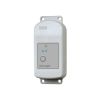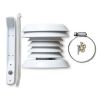Onset HOBO U23 Pro v2 Temp/RH Loggers
Features
- Weatherproof housing for use in outdoor or condensing environments
- Small-diameter external sensor versions for measurements in tight spaces
- Optic USB interface for fast and reliable download
- Expedited repair and warranty service
- Lifetime technical support
- More
Overview
The Onset HOBO Pro v2 logger’s environmentally rugged case is designed for years of reliable use in outdoor applications. It has enough memory to record over 42,000 12-bit measurements.
Data
The logger uses an optical USB communications interface (via a compatible shuttle or base station) for launching and reading out the logger. The optical interface allows the logger to be offloaded without compromising the electronics. The USB compatibility allows for easy setup and fast downloads.
| Temperature Sensor | |
| Operation Range | U23-001A internal sensor: -40 to 70°C (-40 to 158°F) U23-002A external temperature sensor: -40 to 70°C (-40 to 158°F) U23-003 and U23-004 external sensors: -40 to 100°C (-40 to 212°F), with tip and cable immersion in fresh water up to 50°C (122°F) for one year |
| Accuracy | U23-001A and U23-002A: ±0.25°C from -40 to 0°C (±0.45 from -40 to 32°F), ±0.2°C from 0 to 70°C (±0.36 from 32 to 158°F) U23-003 and U23-004: ±0.21°C from 0° to 50°C (±0.38°F from 32° to 122°F); see Plot A |
| Resolution | U23-001A and U23-002A: 0.04°C (0.072°F) U23-003 and U23-004: 0.02°C at 25°C (0.04°F at 77°F); see Plot A |
| Response Time (Typical to 90%) |
U23-001A internal sensor: 10 minutes in air moving 1 m/sec U23-002A external temperature sensor: 3 minutes, 45 seconds in air moving 1 m/sec U23-003 and U23-004 external sensors: 3 minutes in air moving 1 m/sec; 30 seconds in stirred water |
| Drift | U23-001A and U23-002A: <0.01°C (0.018°F) per year U23-003 and U23-004: <0.1°C (0.18°F) per year |
| Relative Humidity Sensor (U23-001A, U23-002A only) | |
| Operation Range | 0 to 100% RH, -40° to 70°C (-40° to 158°F) Exposure to conditions below -20°C (-4°F) or above 95% RH may temporarily increase the maximum RH sensor error by an additional 1% |
| Accuracy | ±2.5% from 10% to 90% RH typical to a maximum of ±3.5% including hysteresis at 25°C (77°F); below 10% and above 90% ±5% typical |
| Resolution | 0.05% |
| Response Time (Typical to 90%) |
U23-001A: 40 minutes in air moving 1 m/sec with protective cap U23-002A: 15 seconds in air moving 1 m/sec |
| Drift | <1% per year typical |
| Logger | |
| Operation Range | -40° to 70°C (-40° to 158°F) |
| Real-time Clock | ±1 minute per month 0° to 50°C (32° to 122°F) |
| Battery | 1/2 AA, 3.6 Volt lithium, user-replaceable (HP-B) |
| Battery Life (Typical Use) | 3 years with 1 minute or greater logging interval |
| Memory (Non-Volatile) | 64K bytes memory (approx. 21,000 temperature and RH measurements) |
| Materials | All models: ASA styrene polymer housing and mounting clamp; polypropylene protective cap; Buna-N o-ring(s); U23-001A, U23-002A only: ASA styrene polymer RH sensor cap; modified hydrophobic polyethersulfone membrane |
| Cables | U23-001A: No cables U23-002A: One 184 cm (6 ft) PVC cable; sensor diameter 1 cm (0.38 in.) U23-003: Two 184 cm (6 ft) PVC cables; sensor diameter 0.5 cm (0.20 in.) U23-004: One 184 cm (6 ft) PVC cable; sensor diameter 0.5 cm (0.20 in.) |
| Environmental Rating | Electronics housing is NEMA 6P equivalent (tolerant of brief submergence); Units with RH sensors are NEMA 4 equivalent (splash-resistant) |
| Launch Modes | Immediate start; delayed start |
| Logging Interval | Fixed-rate or multiple logging intervals, with up to 8 user-defined logging intervals and durations; logging intervals from 1 second to 18 hours |
| Offload Modes | Offload while logging; stop and offload |
| Battery Indication | Battery voltage can be viewed in status screen and optionally logged in datafile. Low battery indication in datafile. |
| Weight | U23-001A: 57 g (1.5 oz); U23-002A: 118 g (3.1 oz); U23-003: 138 g (3.7 oz); U23-004: 102 g (2.7 oz) |
| Dimensions | Housing measures 10.2 × 3.8 cm (4.0 × 1.5 in.) |
| NIST Certificate | Temperature certificate available for additional charge |
- HOBO U23 Pro v2 Temp/RH Logger
- Clamp and mounting screws
- UV protective cap
In The News
Cal Poly, San Luis Obispo Manages Monitoring Efforts in Morro Bay
California Polytechnic State University, San Luis Obispo (Cal Poly, SLO), has been monitoring Morro Bay for decades, and while the monitoring program has changed over the years, the dedication to monitoring the bay has remained the same. The project started in 2006 as a Packard Foundation-funded initiative to monitor water quality flowing in and out of Morro Bay. The goal at the time was to use the data collected to develop and inform an ecosystem-based management plan in collaboration with the Morro Bay National Estuary Program (MBNEP). Since the estuary was the focus at the time, researchers were monitoring water flowing into the estuary from Chorro Creek and Los Osos Creek.
Read MoreGreen Water in Green Bay: Using Data Buoys to Monitor the Southern Bay
While the bay of Green Bay has been referred to as the largest freshwater “estuary” in the world, the watershed hosts intensive agriculture and contributes one-third of Lake Michigan’s total phosphorus load. The Fox River flows into the bay, carrying excess nutrients largely the result of non-point source runoff from the watershed. With a history of deterioration extending well into the last century, the bay ecosystem suffered significant declines in water quality. This, in turn, stimulated major clean-up and ongoing restoration efforts to improve water quality. Tracking these changes is an important aspect of ecosystem management.
Read MoreCross-Border Sewage Contaminated Flows: Monitoring the Tijuana River
The Tijuana River runs across the US-Mexico boundary, flowing into and throughout southern California, carrying with it nutrients and contaminants throughout the estuary. In recent decades, the flows have been heavily polluted with untreated sewage from the City of Tijuana. The wastewater enters the greater Tijuana River estuary, impacting coastal communities and disrupting the natural environment. In order to better understand these cross-border flows, researchers out of San Diego University sought to monitor the waterway test the capabilities of in-situ sensors to measure the contaminated water. Natalie Mladenov and Trent Biggs were two of the researchers involved in the project, deploying a real-time monitoring system in May of 2021.
Read More



















